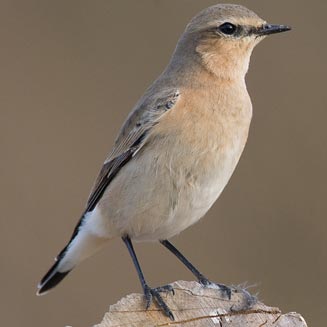|
Oenanthe oenanthe (Northern
wheatear,
European wheatear)
Europese skaapwagter [Afrikaans]; Leucorhoa [Dutch];
Traquet motteux [French]; Steinschmätzer [German]; Chasco-cinzento
[Portuguese]
Life
> Eukaryotes >
Opisthokonta
> Metazoa (animals) >
Bilateria >
Deuterostomia > Chordata >
Craniata > Vertebrata (vertebrates) > Gnathostomata (jawed
vertebrates) > Teleostomi (teleost fish) > Osteichthyes (bony fish) > Class:
Sarcopterygii (lobe-finned
fish) > Stegocephalia (terrestrial
vertebrates) > Tetrapoda
(four-legged vertebrates) > Reptiliomorpha > Amniota >
Reptilia (reptiles) >
Romeriida > Diapsida > Archosauromorpha > Archosauria >
Dinosauria
(dinosaurs) > Saurischia > Theropoda (bipedal predatory dinosaurs) >
Coelurosauria > Maniraptora > Aves
(birds) > Order: Passeriformes
> Family: Muscicapidae > Genus: Oenanthe
 |
 |
|
Northern wheatear, Cork, Ireland. [photo Sean Cronin ©] |
Northern wheatear, New York State, USA. [photo
Christopher L Wood
©] |
Distribution and habitat
It breeds across the northern Hemisphere in North America
and Eurasia, heading south in the non-breeding season to sub-Saharan Africa,
from Mauritania east to south-eastern Egypt and south to Zambia. It is a vagrant
to southern Africa, with about 20 records in northern Namibia, Botswana and
Zimbabwe, southern Mozambique and north-eastern South Africa. It generally
prefers open, degraded Acacia savanna with short grass, barren
boulder-strewn hillsides, burnt grassland, croplands, disturbed Baikiaea
plurijuga (Zambezi teak) and Terminalia woodland with dense grass and
weeds, cattle pens and recently cleared woodland with stumps
Food
It mainly eats invertebrates, using a variety of foraging
techniques such as pouncing on prey on the ground or in the air in sallies
from a perch, gleaning food from vegetation and chasing and catching prey on the
ground. The following food items have been recorded
in its diet:
- Invertebrates
- Seeds
- Fruit
References
-
Hockey PAR, Dean WRJ and Ryan PG 2005. Roberts
- Birds of southern Africa, VIIth ed. The Trustees of the John Voelcker
Bird Book Fund, Cape Town.
|
